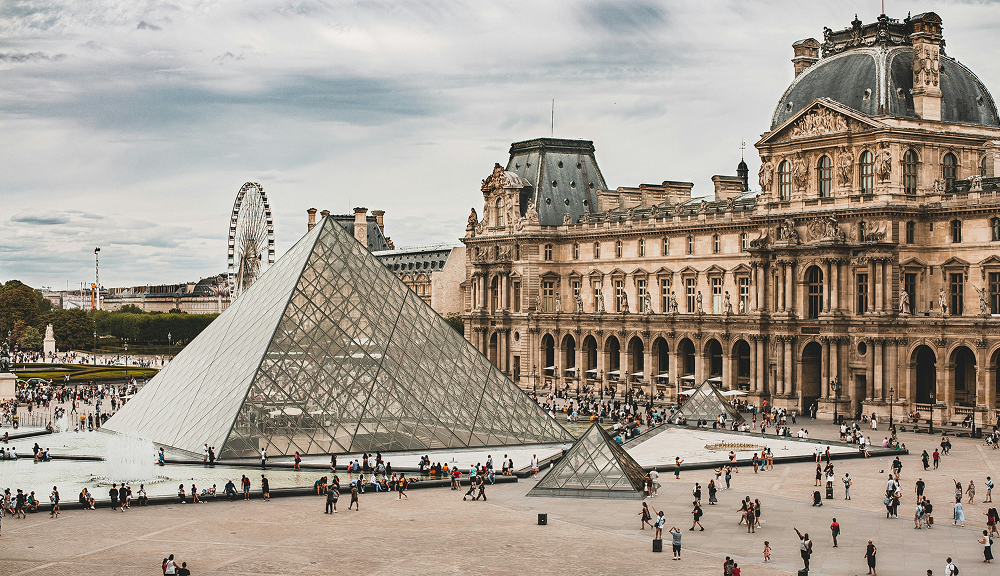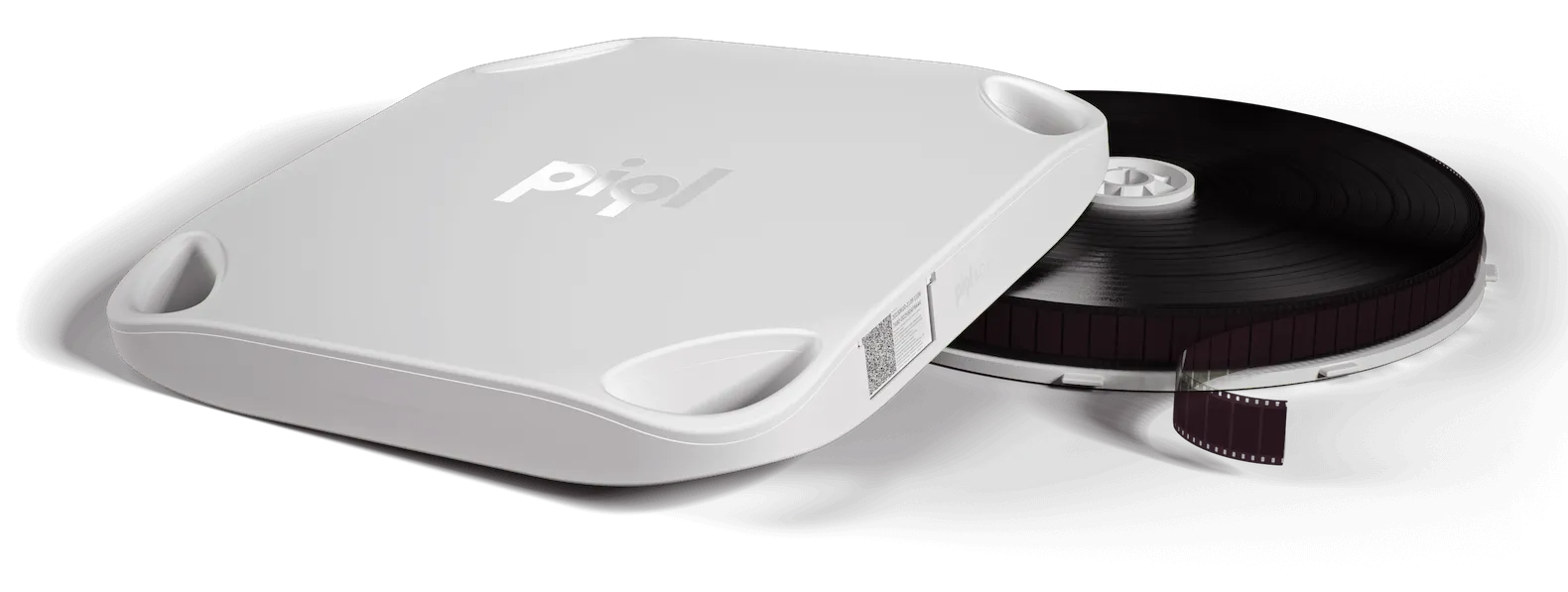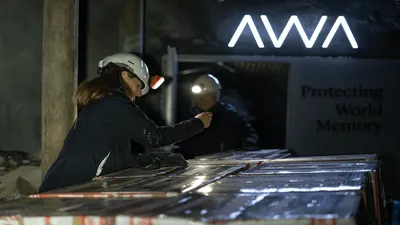

By Sébastien Krajka, Heritage Coordinator at Arctic World Archive (AWA)
Last weekend, France woke up to what some are already calling the heist of the century.
In just seven minutes, four thieves broke into the Louvre Museum and escaped on scooters with eight royal jewels — including a diadem, earrings, and necklaces from France’s Crown collection.

Two pieces were later found, one of them—the crown of Empress Eugénie—damaged beyond repair.
It’s hard not to feel a mix of sadness and disbelief when something like this happens.
Because heritage, in all its forms, is – to me – a bridge between generations. It tells us who we were, who we are, and sometimes, who we could become. When part of it is lost or destroyed, a piece of our collective memory disappears with it.
The growing dangers to our shared heritage
Unfortunately, the Louvre heist isn’t an isolated case. Around the world, cultural heritage faces constant threats — both physical and digital.
Robberies and illicit trafficking
The illicit trade in cultural goods remains a thriving and global criminal business.
According to Europol, a 2025 international operation led to 80 arrests and the seizure of 37,727 cultural goods, including archaeological artifacts and antiquities and the UN Office on Drugs and Crime (UNODC) recently warned that trafficking in cultural property is increasingly managed by organised criminal networks through legitimate markets and online platforms.
Destruction and neglect
From wars to natural disasters, countless monuments, artworks, and archives are lost every year. UNESCO has verified damage to more than 230 cultural sites in Ukraine since the beginning of the conflict and now, the International Criminal Court recognizes deliberate heritage destruction as a potential war crime.
Climate change is another accelerating factor: floods, wildfires, and rising temperatures threaten heritage sites worldwide. According to the UN Environment Programme, one in three natural World Heritage sites is now at risk due to climate change.
Cyberattacks and digital decay
As more institutions digitize their collections, a new and invisible threat has emerged: cybercrime. In July 2025, the French National Museum of Natural History fell victim to a double attack — both a cyber intrusion and a physical break-in.
Hackers infiltrated the museum’s internal network, compromising sensitive research data and digital archives, while intruders stole scientific equipment and computer hardware. This incident is a stark reminder that even the most respected cultural and scientific institutions are not immune to 21st-century threats.
But the danger goes beyond deliberate attacks. Digital heritage is also vulnerable to what we might call digital decay. Hard drives, servers, and cloud platforms — once considered safe — fail with time. File formats become obsolete, software becomes unsupported, and access keys get lost. A study by the Council on Library and Information Resources (CLIR) revealed that up to 30% of early digital archives created before the year 2000 are already inaccessible due to technological obsolescence.
Five ways to protect heritage for the future
1. Eternal preservation with the Arctic World Archive
At Arctic World Archive (AWA), our mission is simple yet ambitious: to ensure that the world’s most valuable knowledge and cultural heritage can never be lost.

Located deep inside a decommissioned mine on the Norwegian island of Svalbard, AWA safeguards humanity’s data beneath the permafrost — safe from war, natural disasters, and digital obsolescence.
Any object — from a single jewel to an entire building — can be 3D scanned, written on piqlFilm, and stored on Svalbard.

piqlFilm is a unique, ultra-durable medium designed to last for over 2,000 years, readable with no proprietary technology, and immune to electromagnetic pulses or digital decay.
It’s the guarantee that even if something is stolen, destroyed, or forgotten, its digital essence will remain — ready to be rediscovered by future generations.
2. Invest in local protection and restoration
Preservation always starts on the ground. Museums, archives, and heritage sites must continue to strengthen their physical protection — not only through cameras and guards, but by rethinking how they secure access, display, and storage.

Technologies such as vibration sensors, humidity monitors, and smart fire suppression systems can make a significant difference in preventing irreversible damage. But equipment alone is not enough: it must be accompanied by clear emergency protocols, staff training, and regular maintenance routines to ensure the system remains reliable.
Local engagement is equally vital. Restoration teams, conservators, and volunteers play a frontline role in safeguarding the material traces of history. Investing in them — through funding, education, and technical partnerships — allows heritage to stay alive within its community. When local actors are empowered to act swiftly after disasters or vandalism, the chances of recovery increase dramatically. Protecting heritage is not only a matter of budget; it’s a matter of presence, preparedness, and pride.
3. Digitize with purpose
Digitization has long been seen as the modern way to protect fragile heritage — but how it’s done makes all the difference. Too often, digitization is treated as a “checklist” activity: scan, upload, store.

True digital preservation, however, requires intention. It means capturing the highest possible fidelity, ensuring metadata accuracy, and using open, interoperable formats that can be read in the future without dependence on a single vendor or software. In short, digital heritage should be both authentic and future-proof.
Digitization also opens new doors for accessibility and education. By turning fragile artifacts into digital twins, museums and archives can share their treasures with the world while reducing physical handling and risk. This not only democratizes access but also helps researchers and educators bring history to life for new audiences. Done well, digitization doesn’t replace the original — it amplifies it, extending its life and meaning far beyond the walls where it resides.
4. Collaborate across borders
Cultural heritage knows no borders — and neither should its protection. In today’s interconnected world, collaboration is one of the most powerful tools we have to defend the legacy of humanity. International partnerships between institutions, governments, and private organizations enable the sharing of resources, expertise, and technologies. Through initiatives like UNESCO’s World Heritage Convention or Europe’s CHARTER Alliance, institutions are already working together to develop best practices and build resilience across continents.
But collaboration also needs to evolve in the digital era. Shared databases, interoperable archives, and joint emergency response networks could transform the way we protect our collective memory. When a museum in Paris can instantly back up its archives with a partner in Oslo or store its digital collection safely in Svalbard, we move from isolated defense to collective strength. Protecting heritage is not a competition; it’s a shared responsibility that requires openness and trust.
5. Educate and inspire the next generation
Inspiring young people to care about history, art, and culture is essential to ensure continuity. Schools, museums, and media have a crucial role to play in helping the next generation understand that heritage is not a static collection of old things, but a living story they are part of. From interactive exhibitions to digital storytelling, every creative effort to make heritage tangible helps plant the seeds of respect and curiosity.

Beyond education, inspiration matters. When people feel emotionally connected to a place, an object, or a story, they are more likely to protect it. Engaging communities through local events, cultural projects, or even social media challenges can transform passive observers into active guardians. The more people see heritage as theirs, the better chance it has to survive — because in the end, preservation isn’t only about storage or technology. It’s about meaning, memory, and belonging.
When I saw the images of the Louvre’s empty display cases, I thought of something simple: the treasures we cherish most are never fully safe in the hands of time. But, maybe, we can outsmart time — with technology, foresight, and a shared sense of responsibility.
At Arctic World Archive, we believe that preserving heritage isn’t just a technical act.
It’s a moral duty to those who came before us, and a legacy to those who will come after. Because one day, the Louvre may rebuild its collection — but the memory of what was lost will only survive if we choose to preserve it today.



